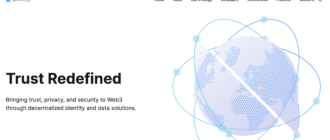TRON is a blockchain-based decentralized platform designed to build a free, global digital content entertainment system with distributed storage technology, which allows easy and cost-effective sharing of digital content. It was founded with the vision of “decentralizing the web” by creating a blockchain-based protocol for a worldwide free content entertainment system.

History of the Project
Founded in September 2017 by Justin Sun, TRON has quickly risen from a promising project to one of the more prominent players in the cryptocurrency space. The TRON Foundation, the organization behind the project, is based in Singapore. TRON made significant headlines with its acquisition of BitTorrent, a move that expanded its ecosystem and integrated BitTorrent’s large user base into the blockchain environment.
What is TRON?
TRON is primarily aimed at revolutionizing the entertainment industry by providing creators full control and ownership over their content, eliminating the middleman. This platform supports various kinds of blockchain networks and smart contracts, including Bitcoin, Ethereum, EOS, and others. TRON includes a high-throughput computing and storage capacity that its network provides, and it operates with a high degree of scalability and availability.
How TRON Works?
TRON is distinguished by its robust technological architecture designed to meet the specific needs of the digital entertainment industry. The platform is built upon a unique set of technologies that contribute to its standout performance and features when compared to other blockchain systems.
TRON Blockchain Architecture
At its core, the TRON blockchain is structured in a multi-layered fashion:
- Storage Layer: This layer utilizes a distributed storage protocol that handles both block and state storage. TRON separates these elements to enhance retrieval and saving efficiencies, which is crucial for handling large-scale data typical in entertainment content.
- Core Layer: This layer includes smart contracts, account management, and consensus. A significant aspect of TRON’s core layer is its support for various blockchain networks through an adaptable protocol layer, enabling seamless interaction with other major cryptocurrencies.
- Application Layer: Developers use this layer to build and deploy decentralized applications (DApps) and custom wallets. TRON’s flexible architecture allows creators to develop personalized blockchain solutions tailored to their needs.
Consensus Mechanism
Originally, TRON employed a Delegated Proof of Stake (DPoS) consensus mechanism which has since evolved. The key aspect of TRON’s consensus model is its reliance on a community of 27 Super Representatives (SRs), elected by TRX token holders. These SRs are responsible for validating transactions and creating blocks, making the process highly decentralized.
- DPoS Evolution: TRON’s DPoS system is designed to be more democratic and efficient compared to traditional Proof of Stake systems. It provides higher throughput and a more scalable network structure. The election cycle for SRs ensures constant community involvement and governance, reinforcing network security and integrity.
Unique Technological Innovations
- TRON Virtual Machine (TVM): The TVM is fully compatible with Ethereum’s virtual machine, which allows developers to execute Ethereum-based smart contracts with minimal modifications. TVM’s compatibility feature simplifies the migration of existing DApps from Ethereum to TRON, broadening TRON’s reach and utility.
- High Throughput: TRON’s network is capable of handling up to 2,000 transactions per second. This high throughput is essential for applications that require real-time data exchange and is particularly beneficial for online gaming and entertainment content sharing.
Differentiating Factors
What sets TRON apart from other blockchain platforms are its high scalability, efficient data storage management, and its strong focus on the entertainment industry. Additionally, TRON’s user-friendly features, such as minimal transaction fees and a low barrier to entry for DApp developers, make it an attractive platform. The integration of BitTorrent further enhances TRON’s capability by leveraging one of the largest peer-to-peer networking infrastructures to handle vast amounts of data transfer, which is a significant advantage in content distribution scenarios.
In summary, TRON’s technology is tailored to foster a decentralized internet and democratize content creation and distribution, providing a unique blend of scalability, efficiency, and specific functionality tailored to the digital entertainment sector.
Smart Contracts on the TRON Network
Smart contracts are pivotal in the TRON ecosystem, enabling the automation of transactions and programmable agreements without the need for intermediaries. This functionality is crucial for developing a decentralized digital content marketplace, where creators can offer their content directly to consumers under clear, predefined conditions.
Characteristics of TRON Smart Contracts
TRON’s smart contracts are designed to be highly efficient and user-friendly, distinguishing them from those on other platforms:
- Compatibility: TRON smart contracts are compatible with Ethereum’s programming language, Solidity. This allows developers who are familiar with creating decentralized applications (DApps) on Ethereum to transition smoothly to TRON.
- Resource Management: To execute smart contracts on the TRON network, three main resources are utilized: bandwidth, energy, and TRX (the native token). Bandwidth allows transactions to be processed without fees, energy is consumed while executing smart contracts to prevent spam, and TRX is used for transactions that require these resources beyond the free quota.
Efficiency and Security
TRON’s smart contracts are designed for high throughput and low latency, which are essential for applications requiring real-time data exchange. The network can handle up to 2,000 transactions per second, making it well-suited for complex DApps involving numerous microtransactions, such as gaming or interactive entertainment platforms.
Security in TRON smart contracts is bolstered through continuous updates and community testing. The platform’s open-source nature allows developers worldwide to identify and rectify vulnerabilities swiftly. TRON also incentivizes the community through bounty programs to ensure robust security protocols.
Development Environment
To aid developers, TRON provides a comprehensive suite of tools:
- TronLink: A browser extension that connects the web browser to the TRON blockchain, enabling websites to interact seamlessly with TRON smart contracts.
- TronStudio: An integrated development environment (IDE) that provides developers with the tools necessary to write, test, and deploy smart contracts. TronStudio includes a private local blockchain for testing, which is critical for ensuring that contracts perform as intended before live deployment.
Impact on Digital Content Distribution
By using smart contracts, creators on the TRON network can automate many aspects of digital content distribution, such as royalty payments, access control, and content licensing. This automation reduces overhead costs and eliminates the need for intermediaries, allowing creators to retain more profits and maintain control over their work.
Tokenomics of TRON: Understanding TRX
TRX, the native cryptocurrency of the TRON network, is a coin, not just a token. As a coin, it powers the entire TRON ecosystem and serves as the medium of exchange for transactions, dApp operation, and other network activities.
Nature and Utility of TRX
TRX is integral to the TRON network as it is used to pay for the resources consumed by executing operations, including running smart contracts and transactions. Unlike tokens, which are often built on existing blockchains, TRX is a fundamental aspect of TRON’s own blockchain.
Emission Model and Distribution
TRON’s total supply is capped, which means there will only ever be a certain number of TRX coins. Originally, the total supply was set at 100 billion TRX. The supply is managed by the TRON Foundation, which initially held a significant portion of TRX for development and strategic partnerships, but these holdings are subject to periodic disbursement to prevent market manipulation.
- Block Rewards: With TRON’s shift from a Proof of Work (PoW) to a Delegated Proof of Stake (DPoS) mechanism, TRX is distributed as block rewards to Super Representatives (SRs) and their voters, which incentivizes participation in network governance and helps maintain network security.
Price Dynamics
The price of TRX, like all cryptocurrencies, is subject to market dynamics and can be volatile. It is influenced by general cryptocurrency market trends, regulatory news, technological advancements within the TRON network, and broader economic factors. The strategic development decisions by the TRON Foundation, such as partnerships and project developments, also significantly impact TRX’s market price.
Staking and Governance
Holders of TRX can engage in staking, locking up their coins to receive rewards while contributing to network security. Staking TRX grants users a say in the network’s governance through voting rights, where they can vote for Super Representatives who validate transactions and make decisions about the network’s future.
Use in the TRON Ecosystem
Within the TRON ecosystem, TRX serves several purposes:
- Transaction Fees: TRX is used to pay for transactions, including transfers and smart contract operations. Although TRON aims to keep transaction costs low, these fees help to prioritize processing and secure the network.
- DApp Interaction: Users must have TRX to interact with DApps on the TRON platform. This includes anything from gaming DApps to decentralized exchanges.
- Content Consumption: In the digital content realm that TRON focuses on, TRX can be used by consumers to pay for access to content or to tip content creators directly.
In summary, the tokenomics of TRX reflect its importance not only as a currency within the TRON ecosystem but also as a tool for network governance and development. The strategic management of its supply and integration into all aspects of the network activities underscores its foundational role in the TRON blockchain.
Where to Buy TRX?
TRX can be purchased on several prominent cryptocurrency exchanges that offer various trading pairs, including fiat to crypto and crypto to crypto transactions. Here are some of the leading exchanges where TRX is available:
- Binance: As one of the largest and most popular cryptocurrency exchanges globally, Binance offers extensive trading pairs for TRX, including against BTC, ETH, BNB, and fiat currencies like USD and EUR.
- HTX (formerly Huobi): HTX is known for its robust platform security and user-friendly interface. It provides several TRX trading pairs, making it a popular choice for traders and investors alike.
- MEXC: This exchange is favored for its wide range of cryptocurrencies and includes multiple trading pairs for TRX. MEXC is known for its user-oriented service with 24/7 online support.
- Bybit: Primarily known for derivatives and futures trading, Bybit also offers spot trading for TRX. It’s known for its straightforward interface and strong trading engine.
- KuCoin: KuCoin is known for offering a wide variety of cryptocurrencies, including TRX. It provides multiple trading pairs and is appreciated for its easy-to-use platform and competitive fees.
- Bitfinex: Offering advanced trading features and high liquidity, Bitfinex is a solid choice for purchasing TRX. It supports several fiat and cryptocurrency pairs with TRX.
Where to Store TRX?
Storing TRX securely is crucial for anyone investing in this cryptocurrency. Here are some recommended wallets for holding TRX:
- TRON Wallet: Officially developed by the TRON Foundation, the TRON wallet is available for desktop and mobile and is considered the most integrated wallet for TRX and other tokens on the TRON network.
- Ledger Nano S/X: For those looking for hardware wallet solutions, Ledger Nano S and X provide robust security by storing TRX offline. They support multiple cryptocurrencies and are known for their security features.
- Trust Wallet: A versatile mobile wallet, Trust Wallet supports TRX along with numerous other cryptocurrencies. It offers an intuitive interface and robust security measures, making it a popular choice for mobile users.
- TronLink: TronLink is extensively used within the TRON community for its seamless integration with TRON DApps. Available as a browser extension and mobile app, it offers convenient access and interaction with the TRON ecosystem.
Each of these wallets offers unique features such as user-friendly interfaces, enhanced security measures, and, in some cases, the ability to interact directly with DApps built on the TRON network. When choosing a wallet, it is essential to consider factors such as security, convenience, and technological compatibility with your intended uses.
Growth Prospects of TRON
The growth trajectory of TRON is anchored in its strategic initiatives, broad partnerships, and the robustness of its technological framework. TRON’s design is geared towards revolutionizing the digital entertainment industry, making it attractive to content creators, media consumers, and developers within the decentralized application (DApp) space.
Strategic Partnerships
TRON has established several partnerships that enhance its ecosystem and expand its market reach:
- Samsung: Integration with Samsung Blockchain Keystore dramatically expands TRON’s accessibility, allowing Samsung smartphone users to easily manage and trade TRX directly from their devices.
- BitTorrent: Acquired by TRON, BitTorrent adds significant value with its massive user base and peer-to-peer file sharing technology, opening up new avenues for content distribution on the blockchain.
- Swisscom Blockchain: This partnership focuses on providing blockchain solutions and expertise, particularly in areas of DApp development and system maintenance, enhancing the TRON network’s performance and reliability.
These partnerships not only broaden TRON’s user base but also enrich its technological capabilities and market presence.
Project Ecosystem and Components
The TRON ecosystem comprises various key components designed to create a fully integrated environment for users and developers:
- TRONIX (TRX): The main utility coin used for transactions and payments within the network.
- TRON Power (TP): Represents voting rights and stakeholder privileges within the network governance model.
- BitTorrent (BTT): Allows content creators to connect with their audience, earn and spend digital currency without a middleman.
- JustSwap: A decentralized trading protocol for automated liquidity provision on TRON.
- TRONWallet: Offers a secure and intuitive interface for managing digital assets and interacting with the blockchain.
- DAppChain: A side-chain scaling solution that significantly improves the performance and efficiency of DApps running on the main TRON blockchain.
This comprehensive ecosystem supports a broad range of applications and ensures that various stakeholder needs are met, from transactional efficiency to interactive engagements.
Development Outlook
Looking ahead, TRON is positioned to further capitalize on the growing popularity of decentralized finance (DeFi) and decentralized content delivery networks (CDN). By enhancing its platform’s scalability and integrating advanced features such as privacy and security protocols, TRON aims to attract a wider array of developers and users, particularly those in the burgeoning sectors of online media and entertainment.
Moreover, TRON’s continuous effort to improve its DPoS consensus mechanism and network infrastructure promises enhanced performance, higher security, and better user engagement across its services.
Conclusion
As a robust platform aimed at revolutionizing the digital entertainment industry, TRON presents a compelling case for both users and developers. Its innovative use of blockchain technology, a strong commitment to decentralization, and continuous improvements to its ecosystem place TRON as a notable entity in the blockchain space, promising significant growth and expansion in the coming years. For advanced users and investors, understanding TRON’s core technologies and strategic potential is crucial for navigating the future of digital content and blockchain technology.






